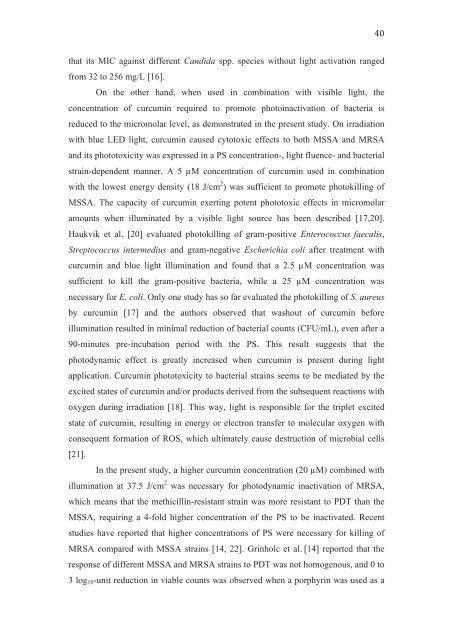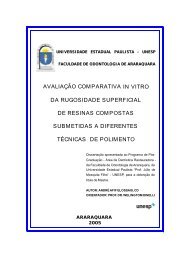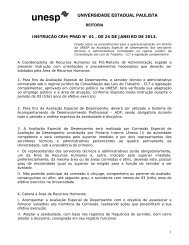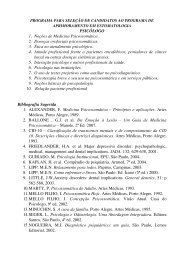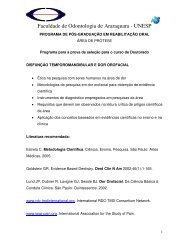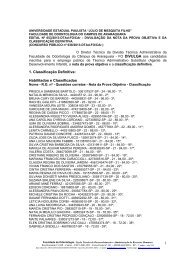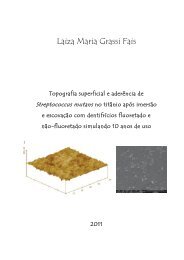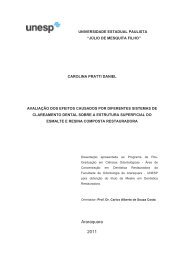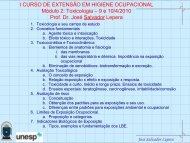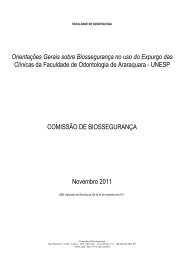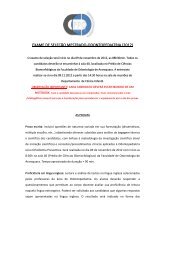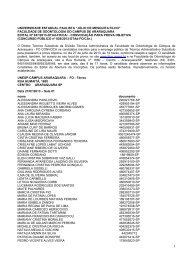Ana Paula Dias Ribeiro - Faculdade de Odontologia - Unesp
Ana Paula Dias Ribeiro - Faculdade de Odontologia - Unesp
Ana Paula Dias Ribeiro - Faculdade de Odontologia - Unesp
- No tags were found...
Create successful ePaper yourself
Turn your PDF publications into a flip-book with our unique Google optimized e-Paper software.
that its MIC against different Candida spp. species without light activation rangedfrom 32 to 256 mg/L [16].On the other hand, when used in combination with visible light, theconcentration of curcumin required to promote photoinactivation of bacteria isreduced to the micromolar level, as <strong>de</strong>monstrated in the present study. On irradiationwith blue LED light, curcumin caused cytotoxic effects to both MSSA and MRSAand its phototoxicity was expressed in a PS concentration-, light fluence- and bacterialstrain-<strong>de</strong>pen<strong>de</strong>nt manner. A 5 µM concentration of curcumin used in combinationwith the lowest energy <strong>de</strong>nsity (18 J/cm 2 ) was sufficient to promote photokilling ofMSSA. The capacity of curcumin exerting potent phototoxic effects in micromolaramounts when illuminated by a visible light source has been <strong>de</strong>scribed [17,20].Haukvik et al. [20] evaluated photokilling of gram-positive Enterococcus faecalis,Streptococcus intermedius and gram-negative Escherichia coli after treatment withcurcumin and blue light illumination and found that a 2.5 µM concentration wassufficient to kill the gram-positive bacteria, while a 25 µM concentration wasnecessary for E. coli. Only one study has so far evaluated the photokilling of S. aureusby curcumin [17] and the authors observed that washout of curcumin beforeillumination resulted in minimal reduction of bacterial counts (CFU/mL), even after a90-minutes pre-incubation period with the PS. This result suggests that thephotodynamic effect is greatly increased when curcumin is present during lightapplication. Curcumin phototoxicity to bacterial strains seems to be mediated by theexcited states of curcumin and/or products <strong>de</strong>rived from the subsequent reactions withoxygen during irradiation [18]. This way, light is responsible for the triplet excitedstate of curcumin, resulting in energy or electron transfer to molecular oxygen withconsequent formation of ROS, which ultimately cause <strong>de</strong>struction of microbial cells[21].In the present study, a higher curcumin concentration (20 µM) combined withillumination at 37.5 J/cm 2 was necessary for photodynamic inactivation of MRSA,which means that the methicillin-resistant strain was more resistant to PDT than theMSSA, requiring a 4-fold higher concentration of the PS to be inactivated. Recentstudies have reported that higher concentrations of PS were necessary for killing ofMRSA compared with MSSA strains [14, 22]. Grinholc et al. [14] reported that theresponse of different MSSA and MRSA strains to PDT was not homogenous, and 0 to3 log 10 -unit reduction in viable counts was observed when a porphyrin was used as a


